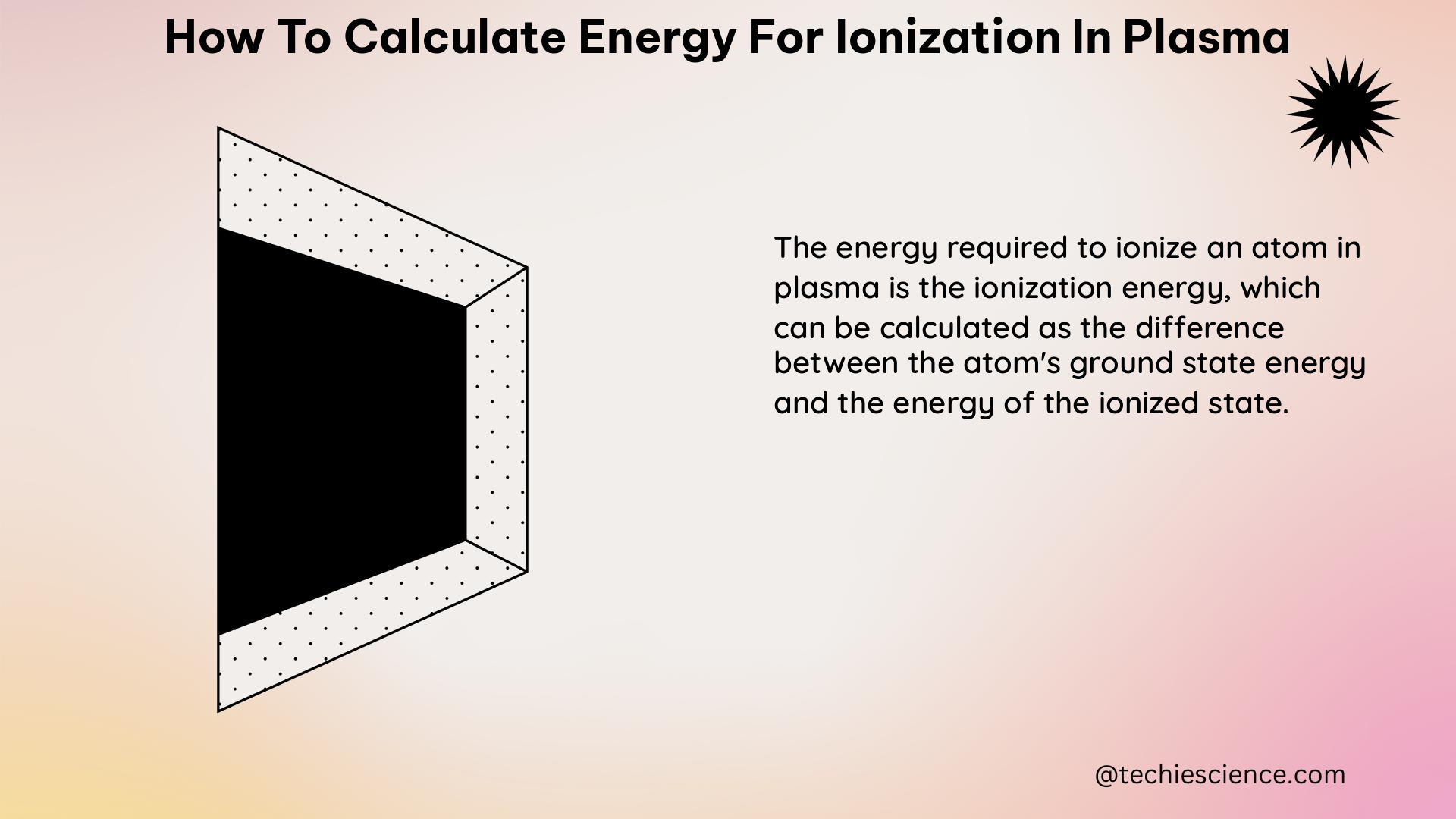Calculating the energy required for ionization in plasma is a crucial step in understanding the behavior and properties of ionized gases. This comprehensive guide will walk you through the key concepts, formulas, and practical applications to help you master the art of calculating ionization energy in plasma.
Understanding Atomic Structure and Ionization Energy
To calculate the energy for ionization in plasma, we need to first understand the fundamental properties of atoms and the energy required to remove an electron from an atom.
Atomic Number (Z) and Atomic Mass (M)
The atomic number (Z) represents the number of protons in the nucleus of an atom, while the atomic mass (M) is the mass of the atom, typically measured in atomic mass units (amu).
Ionization Energy (IE)
Ionization energy (IE) is the energy required to remove an electron from an atom or ion. This energy varies depending on the atomic structure and the energy level of the electron being removed.
The formula for calculating the ionization energy is:
IE = (13.6 eV) × (Z^2) / (n^2)
Where:
– IE is the ionization energy in electron volts (eV)
– Z is the atomic number of the atom or ion
– n is the principal quantum number of the electron being removed
The principal quantum number (n) refers to the energy level of the electron being removed. For example, in a hydrogen atom, the electron in the ground state has a principal quantum number of 1, while the electron in the first excited state has a principal quantum number of 2.
Ionization Energy Examples
Let’s consider some examples of ionization energies:
- Hydrogen (Z=1): IE = 13.6 eV
- Helium (Z=2): IE = 54.4 eV
- Lithium (Z=3): IE = 5.39 eV for the first electron, 75.6 eV for the second electron
- Carbon (Z=6): IE = 11.26 eV for the first electron, 24.38 eV for the second electron
- Oxygen (Z=8): IE = 13.62 eV for the first electron, 35.12 eV for the second electron
These values are experimentally measured and widely accepted in the scientific community.
Calculating Ionization Energy in Plasma

In addition to the ionization energy, the plasma temperature (T) is also a crucial factor in determining the energy required for ionization in plasma.
Plasma Temperature (T)
The plasma temperature can be measured using various techniques, such as optical emission spectroscopy or mass spectrometry. Alternatively, the plasma temperature can be calculated using the Saha-Eggert equation, which relates the degree of ionization to the plasma temperature.
The Saha-Eggert equation is:
(n_i / n_a) = (2 Z_i^2 / Z_a) × (m_e kT / 2πh^2)^(3/2) × exp(-IE / kT)
Where:
– n_i is the number density of ions
– n_a is the number density of atoms
– Z_i is the partition function of ions
– Z_a is the partition function of atoms
– m_e is the mass of an electron
– k is the Boltzmann constant
– T is the plasma temperature
– h is the Planck constant
– IE is the ionization energy
By measuring the number density of ions and atoms, and by knowing the ionization energy and the plasma temperature, you can use the Saha-Eggert equation to calculate the degree of ionization and the energy for ionization in plasma.
Practical Examples and Numerical Problems
Let’s consider a few practical examples to illustrate the calculation of ionization energy in plasma:
Example 1:
Determine the ionization energy required to remove the first electron from a hydrogen atom (Z=1) in a plasma with a temperature of 10,000 K.
Given:
– Z = 1 (hydrogen)
– n = 1 (ground state)
– T = 10,000 K
Using the formula:
IE = (13.6 eV) × (Z^2) / (n^2)
IE = (13.6 eV) × (1^2) / (1^2)
IE = 13.6 eV
Example 2:
Calculate the degree of ionization for a plasma containing helium atoms (Z=2) at a temperature of 20,000 K, given the following data:
– n_i = 1 × 10^16 cm^-3
– n_a = 1 × 10^15 cm^-3
– IE = 54.4 eV
– Z_i = 2
– Z_a = 1
Using the Saha-Eggert equation:
(n_i / n_a) = (2 Z_i^2 / Z_a) × (m_e kT / 2πh^2)^(3/2) × exp(-IE / kT)
(n_i / n_a) = (2 × 2^2 / 1) × (9.11 × 10^-31 kg × 1.38 × 10^-23 J/K × 20,000 K / (2π × 6.63 × 10^-34 J·s)^2)^(3/2) × exp(-(54.4 eV) / (1.38 × 10^-23 J/K × 20,000 K))
(n_i / n_a) = 0.5
Therefore, the degree of ionization is 0.5, or 50%.
These examples demonstrate the application of the ionization energy formula and the Saha-Eggert equation to calculate the energy required for ionization in plasma and the degree of ionization.
Conclusion
Calculating the energy for ionization in plasma is a crucial step in understanding the behavior and properties of ionized gases. By considering the atomic structure, ionization energy, and plasma temperature, you can use the formulas and equations presented in this guide to accurately determine the energy required for ionization in plasma.
Remember, the key to mastering this topic is to practice solving various problems and applying the concepts to real-world scenarios. Good luck with your studies!
References
- Ionization Efficiency – an overview | ScienceDirect Topics: https://www.sciencedirect.com/topics/engineering/ionization-efficiency
- First and second ionization energy (video) | Khan Academy: https://www.khanacademy.org/science/ap-chemistry-beta/x2eef969c74e0d802:atomic-structure-and-properties/x2eef969c74e0d802:periodic-trends/v/first-and-second-ionization-energy
- Ionization Energies of Atoms and Atomic Ions – ResearchGate: https://www.researchgate.net/publication/231266348_Ionization_Energies_of_Atoms_and_Atomic_Ions
- How to Calculate the Ionization Energy of Atoms – YouTube: https://www.youtube.com/watch?v=HxaUHQBtugU
- Quantitative aspects of inductively coupled plasma mass spectrometry: https://www.ncbi.nlm.nih.gov/pmc/articles/PMC5031635/

The lambdageeks.com Core SME Team is a group of experienced subject matter experts from diverse scientific and technical fields including Physics, Chemistry, Technology,Electronics & Electrical Engineering, Automotive, Mechanical Engineering. Our team collaborates to create high-quality, well-researched articles on a wide range of science and technology topics for the lambdageeks.com website.
All Our Senior SME are having more than 7 Years of experience in the respective fields . They are either Working Industry Professionals or assocaited With different Universities. Refer Our Authors Page to get to know About our Core SMEs.